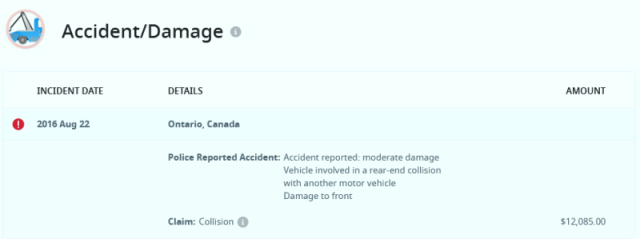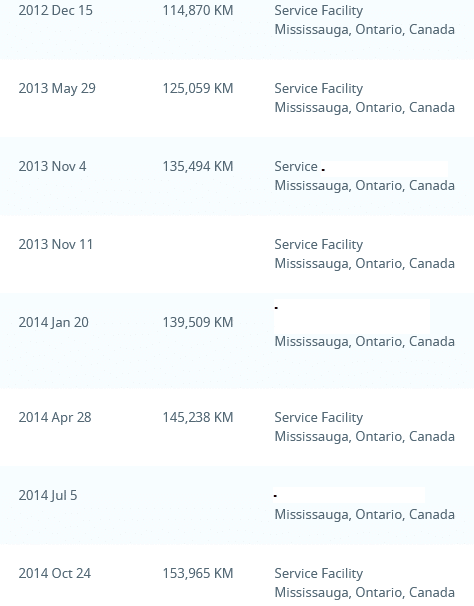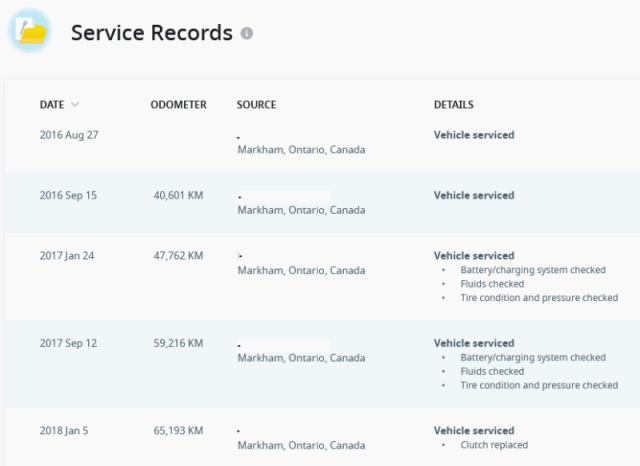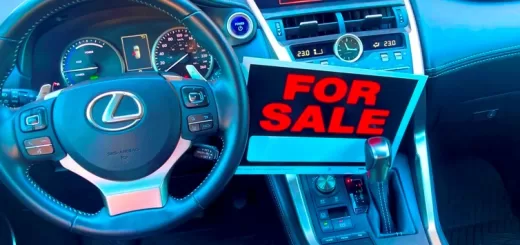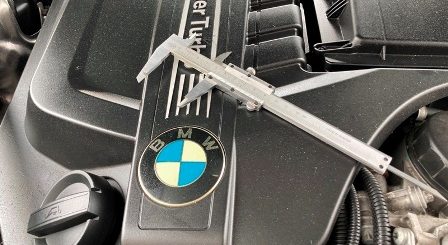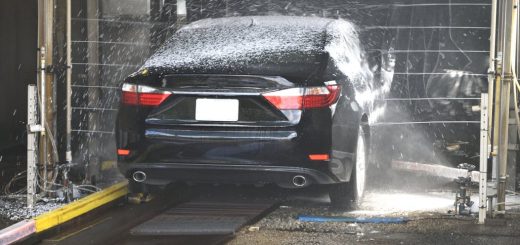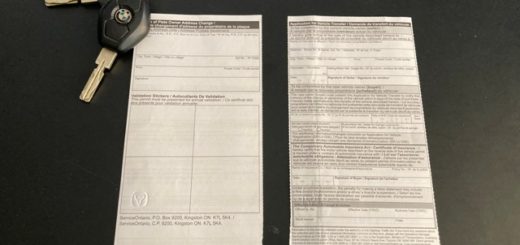How to Check Vehicle History When Buying a Used Car in Ontario
How to Check Vehicle History When Buying a Used Car in Ontario: Whenever financing or paying in cash, buying a used car is one of largest purchase people make in their lifetime. Due diligence is key to get the most out of your hard earned money.
Normally, you can clearly see mechanical or body condition of a used car prior to buying it. You can also have a used car inspected by your mechanic to confirm general mechanical condition. That’s the evidently easy part.
However, what you cannot see is previous history of a used car. Was it involved in accidents, how it was maintained, how many owners, has it been a theft recovery, government vehicle or police car, maybe it was a rental vehicle, had hail or flood damage, Liens or Loans, Rebuilt status, etc. That’s when vehicle history comes in handy to help you make right decisions at right time when buying a used car.
Details on: What to Check When Buying a Used Car.
Most comprehensive vehicle history in Canada (and Ontario) is CARFAX, so will use that as an example. Carfax vehicle history cost about $50 and can be purchased online very easily. You will need only vehicle VIN# and vehicle history is provided instantly to you online once purchased on their website.
Liens or Loans information is sold separately and prices might depend on province, but Ontario as an example cost about $20 extra. Purchasing Liens information is paramount before buying a used car (especially when buying privately) as you don’t want to take a chance buying a vehicle which is still under financing.
How to Check Vehicle History When Buying a Used Car
1- Check Vehicle History For Previous Owners
Number of previous owners is crucial when determining whenever to purchase a used car. You will want as less previous owners as possible, preferably only one owner. As with everything else, when a used car changes hands multiple times, chances are one of owners will neglect maintenance and basically drive vehicle to the ground.
As a rule of thumb, used cars which have had several owners are in worse mechanical and body condition than vehicles with one or two owners. Vehicle history will indicate number of previous owners, helping you make an educated decision when buying a used car.
2- Check Previous Registration History
Registration history is a detailed record of past registrations by Ministry of transportation whenever a used car changed owners and plate renewals every two years. Also, registration history reveals if a vehicle was registered previously in other provinces or countries (USA).
One thing to keep in mind, if a vehicle is registered in several provinces, chances are higher for fraud in odometer tampering and/or hiding previous accidents or other damages. Preferably you should be looking to buy a used car registered only in your province (Ontario only as an example), or at most in two provinces.
3- Check Vehicle History For Accidents and Collisions
This is the most crucial part of vehicle history (Carfax). While a used car can look good in surface, structural problems can be hidden if vehicle has been previously involved in severe accidents. Generally, accidents of $3,000 to $4,000 in insurance claim are not a problem as amount spent indicate superficial damage. Bodywork mostly, such as bumpers, fenders, doors which do not affect vehicle structural integrity.
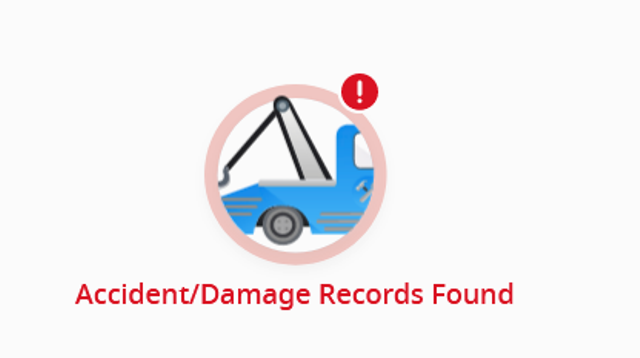
However, when accident claims are higher than say $5,000 then you are looking at possible frame damage and structural repairs. If an accident claim is higher than $10,000 then vehicle most surely suffered severe damages in multiple sides.
Accidents are reported to police, reporting center and insurance. Carfax collect information from all sources to provide you a clear picture including date of accident, location of accident and amount spent in repairs by insurance.
Details on: How to Report a Car Accident in Ontario.
One small detail,when you check vehicle history on accidents and collisions. There are instances when Carfax reports an accident but there is no repair amount provided by insurance, just a police reported accident.
There are several reasons for this. Most common is when owner decides to pay for repairs themselves and chooses to not involve their insurance. In this case you should be looking at police report on Carfax to get an idea how severe accident was.
Police will describe an accident as: Severe damage, Moderate damage or Minor damage. Minor damage being something insignificant such as a scratched bumper or bodywork. Severe damage indicates structural damage with Air Bag deployment and Moderate damage falling somewhere in the middle of the two.
4- Check Odometer Readings on Vehicle History
Carfax reports odometer readings collected from different sources. Main source is Ministry Of Transportation plate registration and ownership changes, as owners are requested to report odometer readings in their vehicles.
Vehicle history also uses secondary sources providing odometer readings, primarily coming from service records at repair facilities. Every time a vehicle is in for repairs or maintenance odometer reading is recorded by service invoice.
Odometer readings should be in ascending order, recent mileage should be higher than previously recorded mileage. As an example, image below shows normal odometer registrations, mileage is in ascending order.
Confirm odometer prior to buying a used car. If you see previous mileage higher than vehicle is currently showing on odometer, walk away as it can potential odometer roll back.
Bear in mind, if you buy a car with potential odometer rollback apart from other problems, you will also have a hard time selling it in the future if you decide to sell it. At the very least you will have to take a significantly lower price than market value.
5- Check For Odometer Discrepancies
In certain cases of mismatching odometer readings can be just a clerical record. Most commonly odometer clerical errors come from repair facilities when a vehicle is sent for maintenance or repairs.
When a clerical error is made at a repair facility, odometer readings can be mistaken as odometer rollback or fraud when in fact is not. This can be easily spotted as all other odometer readings will be normal in ascending order and match current odometer reading in the car.
Another potential discrepancy or clerical error can be with vehicles which are imported from US and have odometer/speedometer in Miles instead of Kilometers.
Repair facilities sometimes will record mileage as they see it on odometer without first converting to Kilometers. As registrations in Canada (Ontario) are registered in Kilometers only, clerical errors will mistakenly show as odometer fraud.
6- Odometer Errors When Buying a Used Car in Ontario
If you are trying to buy a used car, then discuss it with seller to get a clear picture as to what has happened in that period and why odometer readings are not consistent.
Also, you can ask seller to contact Carfax and rectify the problem before you purchase their vehicle. If in doubt or if seller refuses to help with odometer discrepancies, then don’t take a chance and walk away.
As an example: If odometer readings in Carfax go steadily up to 200,000km with a sudden drop to 100,000km and then mileage starts go up from new reading of 100,000km while odometer in vehicle also shows 100,000km or so, then you have an odometer fraud and rollback. Odometer was clearly changed from 200,000km to 100,000km at a certain point in time.
7- Odometer Errors When Selling a Used Car
If you are an owner trying to sell your used car and have one of these discrepancies in vehicle history, contact Carfax and let them know about clerical errors. Carfax is aware of odometer clerical errors and will help revise them.
However, you will be asked to provide proof before they revise odometer errors in vehicle history. Proof includes, photo of present odometer reading in your car, service records, maintenance invoices or other documents where odometer reading has been recorded.
In any case, is well worth it to spend some time and revise your vehicle history if there is a clerical error. Providing a clean vehicle history with consistent odometer readings will help selling your car considerably easier and faster.
8- Check for Service Records When Buying a Used Car
Check vehicle history for service records when buying a used car. Vehicle history (Carfax) collects and provides information from repair facilities. Service records are essential to determine treatment a used car has received by previous owners.
Buying a neglected vehicle which has had almost no preventive maintenance is asking for trouble. Maintenance is crucial in maximizing vehicle longevity and reliability. Maintenance (or lack of it) turns into repair expenses very fast. Whatever maintenance items previous owner neglected, new owner will have to pay for it in repairs.
Read maintenance records thoroughly to understand what was done and what was neglected, especially look for engine oil changes. Also, check period between maintenance records, it should not be more than one year when factoring oil changes.
In any case, reporting service records by repair facilities are not obligatory but voluntary. That means certain repair facilities (small independent shops usually) will not report any service records even when vehicle has been maintained properly and on time. If Carfax report shows no service records then ask seller if they can provide service records invoices.
Details on: Maintenance After Buying a Used Car.
9- Check Lien Records When Buying a Used Car in Ontario
Check vehicle history for Liens when buying a used car. Let’s make this clear: If someone sells you a car and does not reveal their car is still under financing more than likely they plan to take your money and run.
Do not, under any circumstances buy a used car from a private seller without checking for Liens or Loans first.
Lien records can be obtained by purchasing Carfax Lien or buying UVIP or Used Vehicle Information Package. UVIP is sold at any Ministry of Transportation location and cost about $20.
Details on: Buying a Used Car with Lien.
“Vehicle Liens and How Can Affect You” by OMVIC (Ontario Motor Vehicle Industry Council).
10- Check Title History Ontario (Salvage or Rebuilt)
Used car title indicates if a used car has been Salvaged and Rebuilt. Used cars involved in severe accident or collision are sometimes deemed unworthy to be repaired by insurance. Vehicle will be written off as Salvage and sold at an auction.
Usually, these damaged cars are bought by body shops and repair facilities. They will rebuild and put them back on the road. Vehicle title after repairs are completed will show as Rebuilt.
Buying a Rebuilt used car is a gamble. Reason being, you don’t know if repairs were done professionally or repair facility cut corners to save on expenses. Although, Rebuilt cars are sold cheaper, usually 30% cheaper than normal market, one should keep in mind several things when buying one. More on: Buying a Rebuilt Car Ontario.
Carfax (or any other vehicle history) will provide you with information regarding vehicle title. Vehicle title is also noted by Ontario vehicle ownership and on UVIP (Used Vehicle Information Package).
If a vehicle has been rebuilt, Carfax will show it as Rebuilt Title and will also provide you with information about collision date, location and estimation of damages and repairs.
(If you are also looking for a fast and safe solution to sell your car, more here on “How To Sell Your Car Fast” )
11- Check For Theft or Stolen History
Theft history reveals if a vehicle has been stolen in the past (theft recovery). Also, details will be provided if an insurance claim has been filed. Insurance claim reveals how much has been paid to repair damages occurred while vehicle was not in rightful owner’s possession. Also, Carfax history will indicate if a vehicle has a stolen present status.
Details on: What Does “Theft of Vehicle” Means.
12- Check For Vehicle Safety Recalls
Safety recalls are released from car manufacturers when problems with certain components or equipment of vehicle are identified as defective.
If vehicle history shows ‘Open recalls” then you will need to contact closest Dealership to perform necessary repairs. Manufacturer recalls are rectified for free at no charge to customers.
13- Check For US Vehicle or Out Of Country History
Check vehicle history for out of country history. Carfax collects information from US and will show registration in USA if a vehicle originated from United States. In addition, Carfax will provide mileage, accident claims, collisions and vehicle registrations from both sides of the border (US and Canada).
While buying a used car in Ontario which is imported from US is not a problem per se, you need to make sure to check mileage prior and after importation and accident history while vehicle has been in US.
Other Vehicle History Providers
Autocheck is another vehicle history provider in Canada, by Experian. Autocheck same as Carfax has an extended vehicle history. It will provide detains on: previous owners, collision or accident history, registration, maintenance history, vehicle title, odometer readings, import or theft history and open recalls.
Cost for Autocheck reports is $25 per single report, but also gives you an option to purchase 5 reports for $50 which are valid for 21 days. This might come in handy when you need to check multiple vehicles before making final decision on a purchase.
In case you just bought a used car: Maintenance After Buying a Used Car.
Vehicle History When Selling a Used Car
If you are selling your used car privately or to a Dealer, Carfax can come in handy. Providing a vehicle history shows honesty on your part as a seller emphasizing you have nothing to hide.
Prospect buyers feel confident when seller is disclosing all information regarding their used car, making selling process easier and less stressful for all parties involved.
More on: How to Sell Your Used Car Safely and Fast.
Comments: If you have any question or suggestions related to this post or Used-Car-Toronto in general, don’t hesitate to use comment section below.


